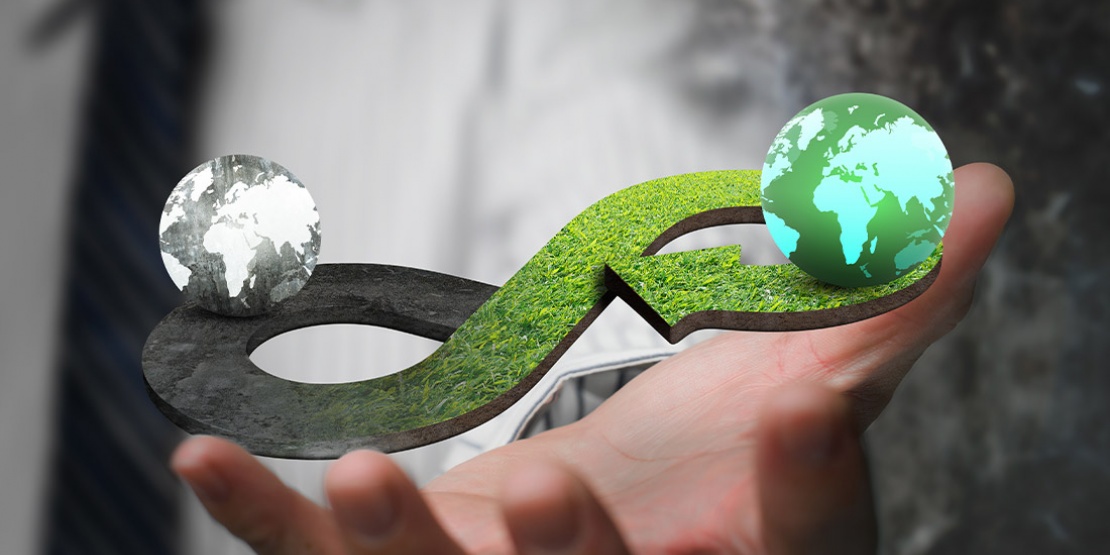A circular economy is good for the planet. It reduces both pressure on resources and greenhouse gas emissions. But is a circular economy good for procurement?
Yes, without a doubt. Used as a basis for procurement strategy and provided it's supported by advanced networks and a suitable organisation, a circular economy is certainly worth buyers' attention. To help understand the concept, here are a few useful reminders:
- The definition of a circular economy
- The benefits of a circular economy
- Examples of circular approaches
What is a circular economy?
A circular economy operates in a loop, i.e. the lifespan of consumables or equipment is extended indefinitely, through reusing, repairing and recycling.
A circular economy, as a pillar of sustainable development, aims to:
- Prevent raw materials from being dumped in landfills, through reuse and recycling.
- Extend the lifespan of equipment by sourcing from the second-hand market or sharing between multiple users.
A circular economy also helps to reduce carbon footprints in multiple ways:
- Savings in natural resources.
- Savings in fluids and energy required for manufacturing and transport.
- Savings in terms of end-of-life product management.
Why choose a circular economy?
A circular economy helps businesses reduce their purchasing costs. Procuring equipment with increased depreciation or reusing materials that no longer need to be mined or manufactured both contribute to lower costs.
That's why pioneering buyers have developed expertise in this area by successfully experimenting with a revolutionary approach: circular procurement.
However, decreased purchasing costs are not the only benefit of a circular economy. Procurement departments can also reap other rewards by adopting a circular approach:
- It helps contribute towards to the company's commitment to CSR.
- It strengthens relationships with customers, who are likely to fuel the cycle in return and/or change their specifications to open up the possibility of a circular economy.
- It invites internal reflection around analysing the value and conditions of use for each procurement category and encourages stronger collaboration with other departments.
How does a circular economy work?
Buying recycled materials
Glass, wood, zinc, aluminium, steel, fabric and even certain types of plastic can all be recycled. Moreover, collection and processing networks are technologically advanced and widely available across the country.
That's why using recycled materials rather than new ones offers two advantages:
- Reduced purchasing costs
- Secured supplies
Buying reconditioned equipment
Some equipment needs to be highly sophisticated and have the latest technology to help companies stand out.
However, a circular approach is ideal for other non-strategic equipment. A value-creating buyer can't afford to ignore it.
Reconditioned equipment is estimated to cost between 20 and 40% less than new equipment. For example, reconditioned stands, compressors or projector equipment for meeting rooms all carry out their function perfectly well.
Sharing the use of existing equipment
Shared purchasing or post-purchase pooling is a third way to contribute towards a circular economy. The total cost of ownership (TCO) is based on the theory that the number of users is significantly reduced, and that the cost is shared across several stakeholders.
This is common approach for corporate jets, for example. However, there are many types of equipment that are seldom used, can be reserved in advance and are therefore well-suited for the B2B sharing economy, both internally and externally.
Using consumables in new ways
Many products, such as cleaning supplies, are made by diluting an active ingredient in water.
Making the final solution on-site, i.e. only buying the active ingredient and adding water as needed, is both common sense and a way of contributing towards a circular economy:
- Decreased transport costs
- Decreased storage costs
In conclusion, a circular economy is the way forward for procurement departments. Circular procurement is therefore an area of expertise that needs to be developed, by working closely with users to help gain a fresh perspective on needs and habits.
Incorporating a circular economy into procurement strategy also plays into the wider discussion on the importance of value creation. For more on this, take a look at the article by Julie Dang Tran, Managing Director of Manutan France: What does the future look like for procurement?









